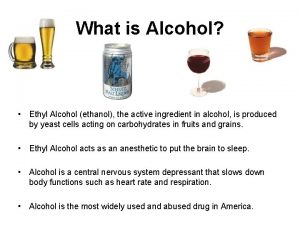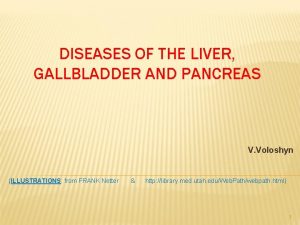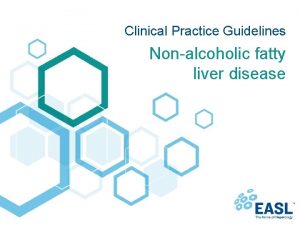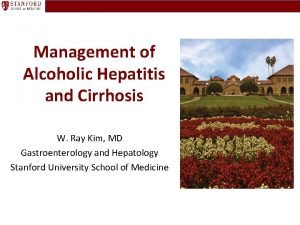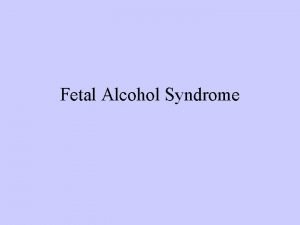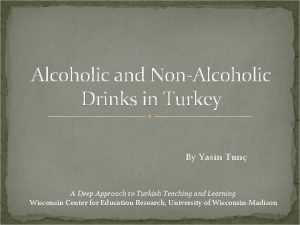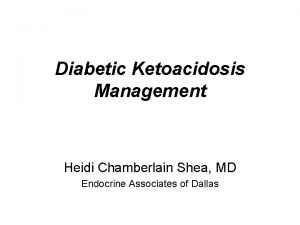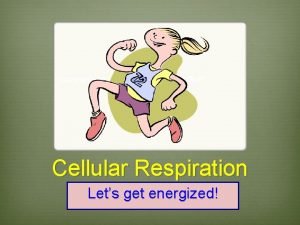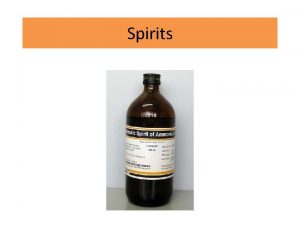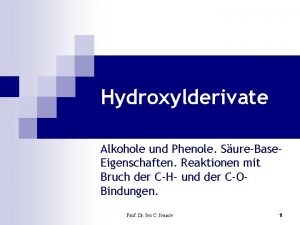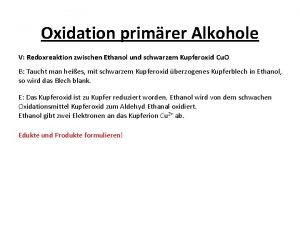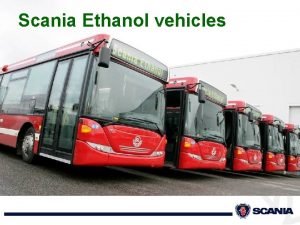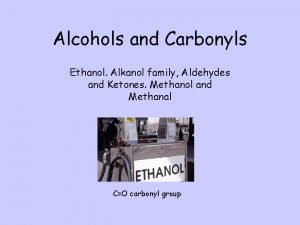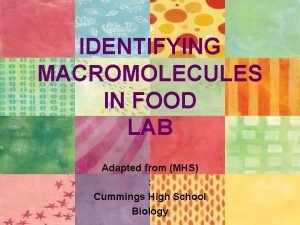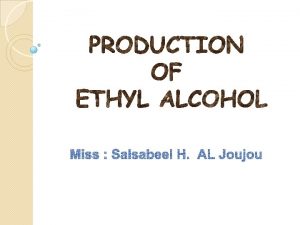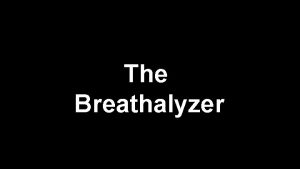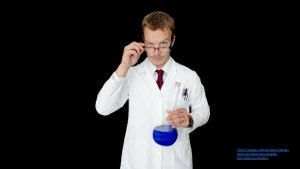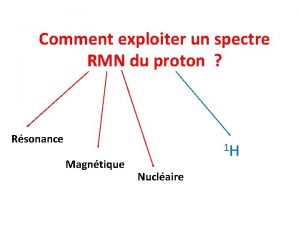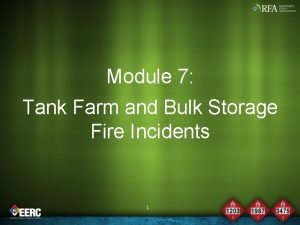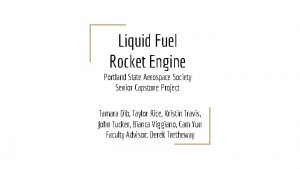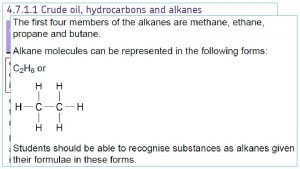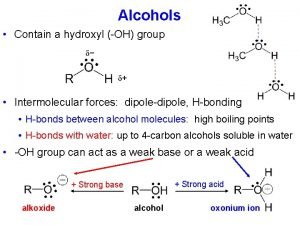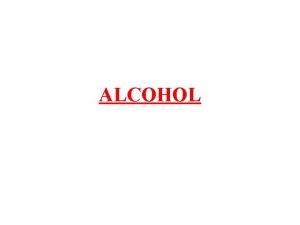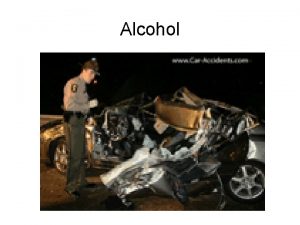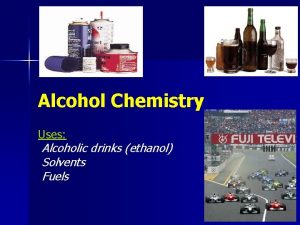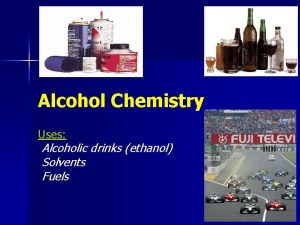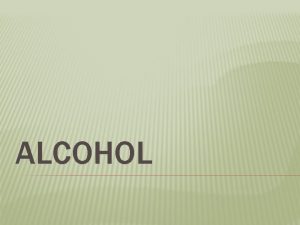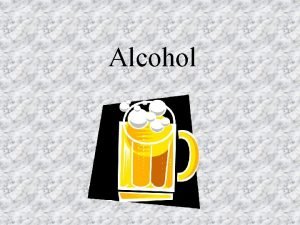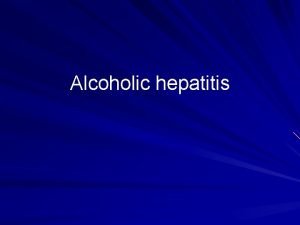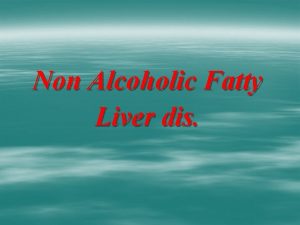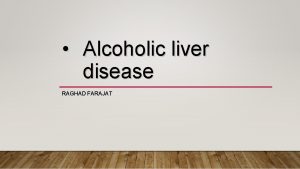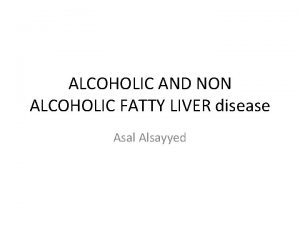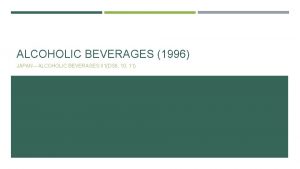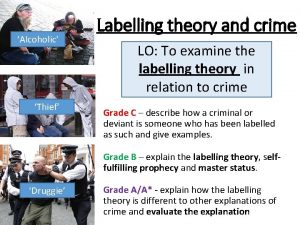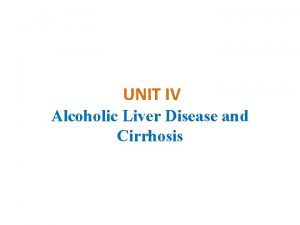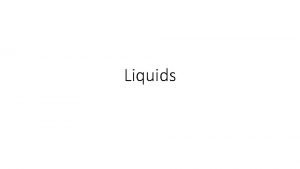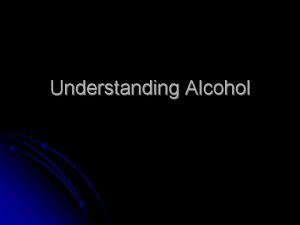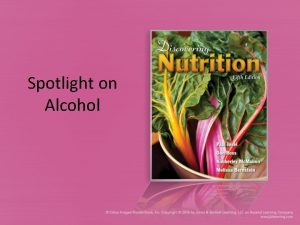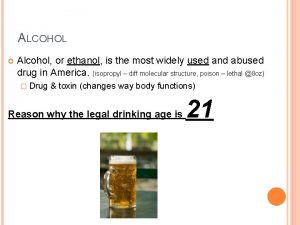Alcohol Ethanol the type of alcohol in alcoholic




































- Slides: 36

Alcohol = Ethanol = the type of alcohol in alcoholic beverages that is a powerful & addictive drug…

Effects of Alcohol 1. At first, drinking alcohol may provide a kind of energy rush. 1. This reaction masks alcohol’s effects as a depressant– a drug that slows the central nervous system. 1. Alcohol quickly affects one’s motor skills by slowing reaction time and impairing vision. 1. The amount of alcohol that leads to intoxication varies from person to person.

DEFINITIONS: • Intoxication / Alcohol Poisoning - the state in which the body is poisoned by alcohol or another substance and the person’s physical & mental control is significantly reduced. • BINGE DRINKING -Consumption of excessive amount of alcohol in a short period of time. Consuming 5 or more drinks (male) or 4 or more drinks (female) in about 2 hours.

WHAT IS A STANDARD DRINK? • 1 12 oz. beer or wine cooler = 5% alcohol • 1 5 oz glass of wine = 12% alcohol • 1. 5 oz of 80 proof distilled spirits (gin, vodka, whiskey ect. ) = 40% alcohol Alcohol content of different types of beer, wine & distilled spirits can vary.

ENERGY DRINKS & ALCOHOL or Energy Drinks With Alcohol • Masks alcohol’s effect • “Wide Awake Drunk” • States that have banned certain energy drinks ( WA, MI, UT, OK & NY) • Red Bull Banned in France, Denmark & Norway

Factors that Influence Alcohol Use 1. Peer pressure 2. Family 3. Media Messages

MEDIA STUDY- OF 200 MOST POPULAR MOVIE RENTALS & 1, 000 POPULAR SONGS: • 98% of movies depicted use of illicit drugs, alcohol & tobacco • Alcohol & tobacco were shown in more than 90% of the movies • Songs - illicit drugs were mentioned in 63% of rap songs • 27% of music showed reference to either alcohol or drugs

MORE MEDIA: • TV - alcohol was mentioned in 77% of episodes - tobacco in 22% & illicit drugs in 20% of TV programs • Media contributes to the notion that “everyone uses alcohol & drugs”

FAMILY RISK FACTORS“RISK IS NOT DESTINY” • 50% of today’s alcoholics are children of alcoholics • Boy’s in particular have a high risk • Parental use – learning through observation • Absence of praise & low expectations of a child’s success. (Low Self Esteem) Source - NAIAAA

Very Young Alcoholics • The total # of underage drinkers has remained the same since the early 1990’s • 20% of 8 th graders • 58% of 12 th graders • Report being drunk at least once in their lives.

Much Earlier • These stat’s disguise a more disturbing fact: kids who drink are starting earlier • One third of kids age 12 -17 had their first drink before 13.

Other studies: • University of Michigan - a significant # of 13 yr. old drinkers reported starting at age 11. • Partnership for a Drug Free America - nearly 10% of 9 yr. olds - or 427, 000 have tried alcohol.

Results: • Children who start drinking before age 15 are FOUR times likely to have latter problems with alcohol abuse than those who started drinking @ 21.

Young Drinkers - host of other troubles: • Abuse of different drugs. • Possible impairment of critical, developing brain areas. • Accidents • Suicides • Homicides

Other Problems- more likely to be: • Victims of violent crimes • To have unprotected sex To Contract STDs • To get pregnant • 4 X more likely to be in a car crash

Risk Factors -children at risk for early drinking may also: • Have a close friend or sibling who uses alcohol or other drugs - one of the strongest predictors. • Tend to hold in anger or negative feelings - or fly off the handle too easily (poor impulse control). • Research shows a relationship between aggressive K -2 males & abuse. • Be socially awkward

Risk Factors • Engage in risk-taking behavior • Have parents who don’t keep track of their whereabouts or behavior

Risk continued • Have experienced trauma - divorce or childhood abuse • Receive harsh or inconsistent discipline from parents • Do poorly in school - especially grades 4 -7, if a child loses interest in school they are at greater risk.

Prevention • Start the conversation about alcohol early - by the time the child is 9 or 10 or earlier. • Message to Parents - Keep track of how much alcohol is in your home - 1/3 of 6 th-9 th graders polled said they get alcohol from home.

More Parent/Teacher Info…… • Let children know that you don’t think underage drinking is just a “right of passage” or okay in any way. Teen drinking is against the law.

More Parent Info …. . • Get acquainted with the parents of your kids friends and ask their attitudes toward underage drinking. • Create a consistent policy on alcohol that you jointly communicate to your kids. • Don’t let kids go to homes that aren’t supervised by adults

Where to go for help? • Leadership To Keep Children Alcohol Free • Alcoholfreeschildren. org • National Institute on Alcohol, Abuse & Alcoholism • Niaaa. nih. gov

Refusal Skills - K-5 1. Look at the person. Say “No” 2. Tell why you are saying “no” 3. Do not change your mind. 4. Ask for help from an adult if you need it.

Harmful Effects of Alcohol Use • Short Term Effects: – Nervous System- Brain- Movement, speech & vision may be affected – Memory- thought processes are disorganized; memory & concentration are dulled – Judgment- Judgment is altered and coordination impaired

Short Term Effects Cont… – Cardiovascular System- Heart- increase in heart rate and blood pressure – Blood Vessels- Alcohol causes blood vessels to expand • Allows body heat to escape & body temp’s to drop – Digestive System- Stomach- Alcohol passes quickly from the stomach into the bloodstream • Stomach acid production increases and often results in nausea & vomiting

– Liver- toxic chemicals are released as the liver metabolizes alcohol • This causes inflammation & scarring – Kidneys- alcohol causes the kidneys to increase urine output which can lead to dehydration – Respiratory System- lungs- carbon dioxide formed by the liver is released from the body through the lungs – Breathing- alcohol depresses nerves that control involuntary functions such as breathing • With excessive amounts, breathing may be slow or irregular or may stop

Effects on Family & Society 1. Alcohol use is the major factor in the 4 leading causes of accidental death– car accidents, falls, drowning and house fires are the others 2. It plays a major role in violent crimes– homicide, forcible rape & robbery 3. 40% of violent crimes– totaling 3 million dollars annually are alcohol related 4. Two thirds of victims who encounter domestic violence report that alcohol was the factor 5. Nearly half of all homicide victims have alcohol in their bloodstream

Fetal Alcohol Syndrome (FAS) • A group of alcohol related birth defects that include physical & mental problems • A baby may have the following problems: – Born with small head & deformities of the face, hands or feet – Heart, liver, and kidney defects as well as vision & hearing problems – Might also experience slow growth & coordination and have difficulties with learning, attention, memory & problem solving.

FAS • 10, 000 American babies are born with FAS with another 30, 000 infants less obviously affected • The US spends $5 billion a yr on FAS syndrome

Alcoholism • A disease in which a person has a physical or psychological dependence on drinks that contain alcohol • 17 million or 1 in 12 adults abuse alcohol

3 Stages of Alcoholism 1. Abuse- begin with social drinking in an attempt to relax- over time dependence develops n One drinks to become intoxicated regularly which can result in blackouts & memory loss n Person begins to lie or make excuses about their drinking n The person consumes alcohol to feel the desired effect n This person become a problem drinker

2. Dependence- The person cannot stop drinking & is physically dependent • Alcohol becomes the central focus • Drinker tries to hide the problem • Soon job, school performance suffers and so does home life • Drinker makes excuses & blames others for problems

3. Addiction- Alcohol is the most important thing in the person’s life. Their life is out of control although the person may not realize it. Liver is damaged and less alcohol is required to produce intoxication if alcoholic stops drinking they will suffer from severe withdrawal symptoms

Treatment • Alcoholism cannot be cured but treated! • Two thirds of all alcoholics who try to recover do so with proper treatment – This occurs through counseling & medication • Recovery = process of learning to live an alcohol free life • Sobriety = living without alcohol

Steps to Recovery 1. Admission- person admits to having a problem & asks for help 1. Detoxification- process in which body adjusts to functioning without alcohol 1. Counseling- learning to live without alcohol 1. Recovery- the person takes responsibility for his/her own life

The End…
 How much ethanol in alcohol
How much ethanol in alcohol Secondary alcohols
Secondary alcohols Primary and secondary alcohol oxidation
Primary and secondary alcohol oxidation Edgar allan poe carbon monoxide poisoning
Edgar allan poe carbon monoxide poisoning Alcoholic hepatitis
Alcoholic hepatitis Elisabetta bugianesi
Elisabetta bugianesi Cirrhosis
Cirrhosis Alcoholic brain vs normal brain
Alcoholic brain vs normal brain Turkish drinks non alcoholic
Turkish drinks non alcoholic What is alcoholic fermentation
What is alcoholic fermentation Alcoholic ketoacidosis
Alcoholic ketoacidosis White liniment preparation
White liniment preparation Division of alcoholic beverages and tobacco
Division of alcoholic beverages and tobacco Alcoholic fermentation steps
Alcoholic fermentation steps Hydroalcoholic solutions are:
Hydroalcoholic solutions are: Lesbian symbol in genogram
Lesbian symbol in genogram Alkanole
Alkanole Is acetic acid ionic or covalent
Is acetic acid ionic or covalent Physical characteristics of ethanol
Physical characteristics of ethanol Dry mill ethanol process
Dry mill ethanol process Reaktion ethanol mit kupferoxid
Reaktion ethanol mit kupferoxid Ethanol
Ethanol Uses of ethanol
Uses of ethanol Sudan iv test
Sudan iv test Uses of ethanol
Uses of ethanol Breathalyzer reaction
Breathalyzer reaction Ethansäure ethanol
Ethansäure ethanol Spectre rmn paracétamol
Spectre rmn paracétamol Switchgrass vs corn ethanol
Switchgrass vs corn ethanol Ethanol ethyl murni
Ethanol ethyl murni Is ethanol bulk gaining or reducing
Is ethanol bulk gaining or reducing 1/18
1/18 Ethanol to ethene reaction
Ethanol to ethene reaction Covalent bond of ethanol
Covalent bond of ethanol Ethanol emulsion test for lipids
Ethanol emulsion test for lipids How to make ethanol
How to make ethanol Ethyl propyl ether structure
Ethyl propyl ether structure
